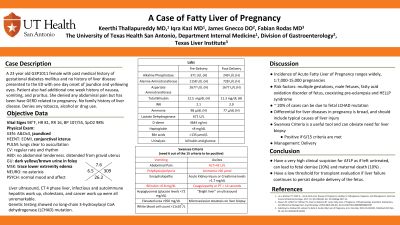Tuesday Poster Session
Category: Liver
P3939 - A Case of Fatty Liver of Pregnancy
Tuesday, October 24, 2023
10:30 AM - 4:00 PM PT
Location: Exhibit Hall

Has Audio

Keerthi Thallapureddy, MD
UT Health San Antonio
San Antonio, TX
Presenting Author(s)
Keerthi Thallapureddy, MD1, Iqra Kazi, MD1, James Gnecco, DO2, Fabian V. Rodas, MD3
1UT Health San Antonio, San Antonio, TX; 2University of Texas Health Science Center at San Antonio, San Antonio, TX; 3Texas Liver Institute/UTHSCSA, San Antonio, TX
Introduction: Acute fatty liver of pregnancy (AFLP) is a rare, potentially life-threatening emergency characterized by severely elevated liver enzymes, typically in the third trimester of pregnancy. Initial symptoms are nonspecific and can progress to abdominal pain, nausea, vomiting, encephalopathy, jaundice, icterus, hypertension, edema, ascites, asterixis and symptoms of hypoglycemia. We present a case of a young pregnant female with features consistent with diagnosis of AFLP.
Case Description/Methods: A 23-year-old G3P1011 obese female with diet-controlled gestational diabetes, history of cholecystectomy, and no history of liver disease presented at 35w1d with 1 day onset of jaundice and 1 week history of nausea, vomiting and pruritus. Physical exam revealed jaundice, conjunctival icterus, trace lower extremity edema, with no asterixis, abdominal tenderness or signs of encephalopathy. Initial labs consisted of AST 2677, ALT 1158, alkaline phosphatase (ALP) 371, total bilirubin (T-Bili) 12.5, INR 2.1, platelets 309, ammonia 98, lactate dehydrogenase 671, D-dimer 4,644, haptoglobin < 8, and total bile acids >135. Ultrasound and CT 4 phase of liver were unremarkable. Infectious, autoimmune, cholestasis, and cancer workup were also negative. Due to concern for AFLP, she underwent emergent vaginal delivery. Post-partum, her labs improved to AST 1081, ALT 526, ALP 233, T-Bili 7.6, INR 1.1, platelets 268, and ammonia 77.
Discussion: The incidence of AFLP ranges widely, occurring in 1:7000-15,000 pregnancies. Risk factors include multiple gestations, male fetuses, fatty acid oxidation disorder of the fetus, coexisting pre-eclampsia, and HELLP syndrome. The differential in liver diseases of pregnancy is broad but should include typical causes of hepatitis including infectious, autoimmune, and genetic in addition to diseases of pregnancy. While histology typically demonstrates evidence of microvascular steatosis, the Swansea Criteria is a tool that is used to help diagnose and can obviate need for biopsy. With a 100% sensitivity and 85% positive predictive value, the Swansea Criteria is considered positive if 6 out of the 15 criteria are met (TABLE 1). Our patient met 8 of the criteria markers, confirming diagnosis of AFLP. Delivery of the baby in the majority of cases will resolve AFLP. Though the differential for liver disease in pregnancy is broad, having a very high clinical suspicion for AFLP is crucial. If left untreated, it can lead to fetal demise (10%) and maternal death (10%) due to acute liver failure.
Disclosures:
Keerthi Thallapureddy, MD1, Iqra Kazi, MD1, James Gnecco, DO2, Fabian V. Rodas, MD3. P3939 - A Case of Fatty Liver of Pregnancy, ACG 2023 Annual Scientific Meeting Abstracts. Vancouver, BC, Canada: American College of Gastroenterology.
1UT Health San Antonio, San Antonio, TX; 2University of Texas Health Science Center at San Antonio, San Antonio, TX; 3Texas Liver Institute/UTHSCSA, San Antonio, TX
Introduction: Acute fatty liver of pregnancy (AFLP) is a rare, potentially life-threatening emergency characterized by severely elevated liver enzymes, typically in the third trimester of pregnancy. Initial symptoms are nonspecific and can progress to abdominal pain, nausea, vomiting, encephalopathy, jaundice, icterus, hypertension, edema, ascites, asterixis and symptoms of hypoglycemia. We present a case of a young pregnant female with features consistent with diagnosis of AFLP.
Case Description/Methods: A 23-year-old G3P1011 obese female with diet-controlled gestational diabetes, history of cholecystectomy, and no history of liver disease presented at 35w1d with 1 day onset of jaundice and 1 week history of nausea, vomiting and pruritus. Physical exam revealed jaundice, conjunctival icterus, trace lower extremity edema, with no asterixis, abdominal tenderness or signs of encephalopathy. Initial labs consisted of AST 2677, ALT 1158, alkaline phosphatase (ALP) 371, total bilirubin (T-Bili) 12.5, INR 2.1, platelets 309, ammonia 98, lactate dehydrogenase 671, D-dimer 4,644, haptoglobin < 8, and total bile acids >135. Ultrasound and CT 4 phase of liver were unremarkable. Infectious, autoimmune, cholestasis, and cancer workup were also negative. Due to concern for AFLP, she underwent emergent vaginal delivery. Post-partum, her labs improved to AST 1081, ALT 526, ALP 233, T-Bili 7.6, INR 1.1, platelets 268, and ammonia 77.
Discussion: The incidence of AFLP ranges widely, occurring in 1:7000-15,000 pregnancies. Risk factors include multiple gestations, male fetuses, fatty acid oxidation disorder of the fetus, coexisting pre-eclampsia, and HELLP syndrome. The differential in liver diseases of pregnancy is broad but should include typical causes of hepatitis including infectious, autoimmune, and genetic in addition to diseases of pregnancy. While histology typically demonstrates evidence of microvascular steatosis, the Swansea Criteria is a tool that is used to help diagnose and can obviate need for biopsy. With a 100% sensitivity and 85% positive predictive value, the Swansea Criteria is considered positive if 6 out of the 15 criteria are met (TABLE 1). Our patient met 8 of the criteria markers, confirming diagnosis of AFLP. Delivery of the baby in the majority of cases will resolve AFLP. Though the differential for liver disease in pregnancy is broad, having a very high clinical suspicion for AFLP is crucial. If left untreated, it can lead to fetal demise (10%) and maternal death (10%) due to acute liver failure.
Disclosures:
Keerthi Thallapureddy indicated no relevant financial relationships.
Iqra Kazi indicated no relevant financial relationships.
James Gnecco indicated no relevant financial relationships.
Fabian Rodas indicated no relevant financial relationships.
Keerthi Thallapureddy, MD1, Iqra Kazi, MD1, James Gnecco, DO2, Fabian V. Rodas, MD3. P3939 - A Case of Fatty Liver of Pregnancy, ACG 2023 Annual Scientific Meeting Abstracts. Vancouver, BC, Canada: American College of Gastroenterology.
